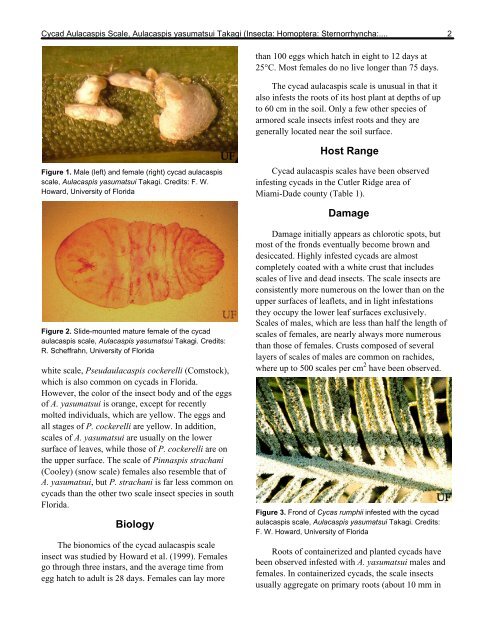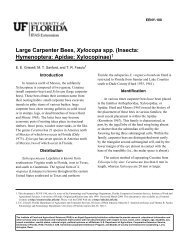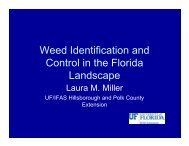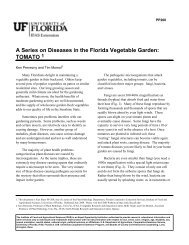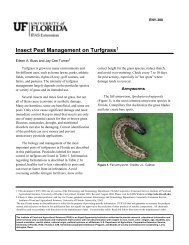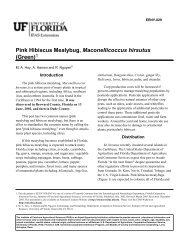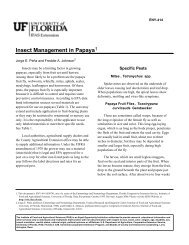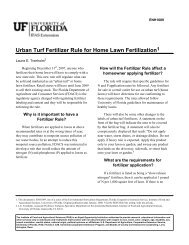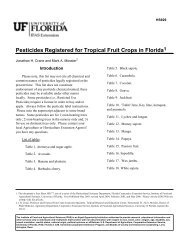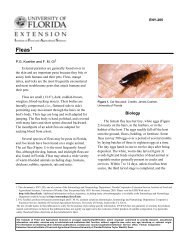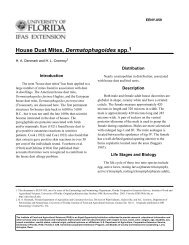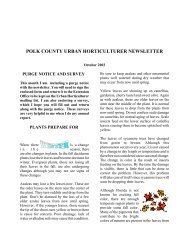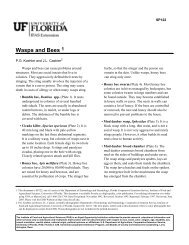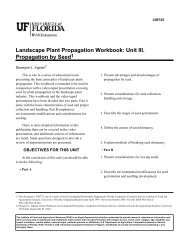Cycad Aulacaspis Scale, Aulacaspis yasumatsui Takagi (Insecta ...
Cycad Aulacaspis Scale, Aulacaspis yasumatsui Takagi (Insecta ...
Cycad Aulacaspis Scale, Aulacaspis yasumatsui Takagi (Insecta ...
You also want an ePaper? Increase the reach of your titles
YUMPU automatically turns print PDFs into web optimized ePapers that Google loves.
<strong>Cycad</strong> <strong>Aulacaspis</strong> <strong>Scale</strong>, <strong>Aulacaspis</strong> <strong>yasumatsui</strong> <strong>Takagi</strong> (<strong>Insecta</strong>: Homoptera: Sternorrhyncha:.... 2<br />
Figure 1. Male (left) and female (right) cycad aulacaspis<br />
scale, <strong>Aulacaspis</strong> <strong>yasumatsui</strong> <strong>Takagi</strong>. Credits: F. W.<br />
Howard, University of Florida<br />
Figure 2. Slide-mounted mature female of the cycad<br />
aulacaspis scale, <strong>Aulacaspis</strong> <strong>yasumatsui</strong> <strong>Takagi</strong>. Credits:<br />
R. Scheffrahn, University of Florida<br />
white scale, Pseudaulacaspis cockerelli (Comstock),<br />
which is also common on cycads in Florida.<br />
However, the color of the insect body and of the eggs<br />
of A. <strong>yasumatsui</strong> is orange, except for recently<br />
molted individuals, which are yellow. The eggs and<br />
all stages of P. cockerelli are yellow. In addition,<br />
scales of A. <strong>yasumatsui</strong> are usually on the lower<br />
surface of leaves, while those of P. cockerelli are on<br />
the upper surface. The scale of Pinnaspis strachani<br />
(Cooley) (snow scale) females also resemble that of<br />
A. <strong>yasumatsui</strong>, but P. strachani is far less common on<br />
cycads than the other two scale insect species in south<br />
Florida.<br />
Biology<br />
The bionomics of the cycad aulacaspis scale<br />
insect was studied by Howard et al. (1999). Females<br />
go through three instars, and the average time from<br />
egg hatch to adult is 28 days. Females can lay more<br />
than 100 eggs which hatch in eight to 12 days at<br />
25°C. Most females do no live longer than 75 days.<br />
The cycad aulacaspis scale is unusual in that it<br />
also infests the roots of its host plant at depths of up<br />
to 60 cm in the soil. Only a few other species of<br />
armored scale insects infest roots and they are<br />
generally located near the soil surface.<br />
Host Range<br />
<strong>Cycad</strong> aulacaspis scales have been observed<br />
infesting cycads in the Cutler Ridge area of<br />
Miami-Dade county (Table 1).<br />
Damage<br />
Damage initially appears as chlorotic spots, but<br />
most of the fronds eventually become brown and<br />
desiccated. Highly infested cycads are almost<br />
completely coated with a white crust that includes<br />
scales of live and dead insects. The scale insects are<br />
consistently more numerous on the lower than on the<br />
upper surfaces of leaflets, and in light infestations<br />
they occupy the lower leaf surfaces exclusively.<br />
<strong>Scale</strong>s of males, which are less than half the length of<br />
scales of females, are nearly always more numerous<br />
than those of females. Crusts composed of several<br />
layers of scales of males are common on rachides,<br />
where up to 500 scales per cm 2 have been observed.<br />
Figure 3. Frond of Cycas rumphii infested with the cycad<br />
aulacaspis scale, <strong>Aulacaspis</strong> <strong>yasumatsui</strong> <strong>Takagi</strong>. Credits:<br />
F. W. Howard, University of Florida<br />
Roots of containerized and planted cycads have<br />
been observed infested with A. <strong>yasumatsui</strong> males and<br />
females. In containerized cycads, the scale insects<br />
usually aggregate on primary roots (about 10 mm in


